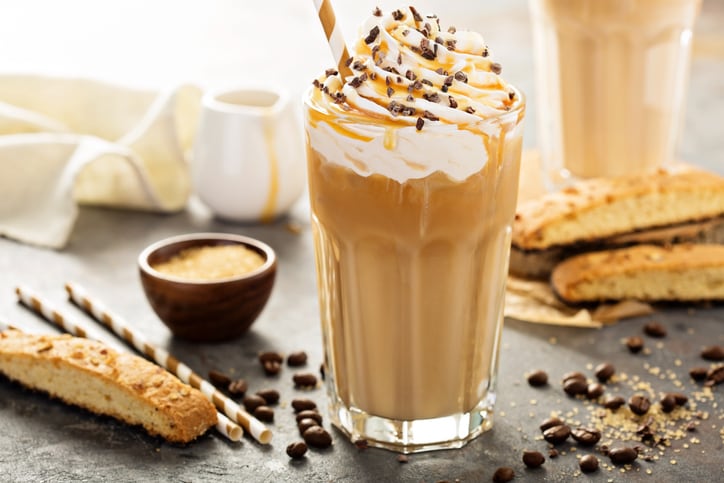Ready-to-drink coffee is booming. And that’s particularly the case among younger generations, who are attracted by drinks that are often sweeter, indulgent and instantly Instagrammable. In fact, the global RTD coffee market is expected to show a CAGR of 8.54% 2020-2032, reaching $64.78bn by 2032, according to Fortune Business Insights.
One of the reasons for the category’s popularity is that it takes the indulgent café experience into an on-the-go format. They also turn to RTD coffee as a ‘healthier’ alternative to soda.
But many RTD coffees can contain high levels of sugar and fat. In the US, many iced coffees contain more added sugar than the FDA recommends consuming in an entire day; others contain far more sugar than that found in soda.
They are also frequently milk-based: using whole milk for a thicker, luxury experience.
It’s only a matter of time before consumers start to question RTD’s coffee’s credentials.
Can RTD coffee keep its cool?
With its health conscious consumer in mind, Australian RTD coffee company, Hunt and Brew, wants to champion a new way of thinking about RTD coffee.
Unlike many others, the brand contains no added sugar: the naturally-occurring sugars from lactose in milk bring the brand’s milk-based SKUs in at 3.1g per 100ml.
But it’s an outlier: many RTD coffees on the market “are not coffee, they’re dessert in a bottle,” as Andrew Douglas from Hunt and Brew tells us.
“There are definitely brands doing it right: but they’re the exception, not the rule,” he said.
Right now, RTD coffee is booming among Gen Z, who are primarily turning to the category for novelty and energy. But as the category grows and expands, it will be held under much greater scrutiny. That could be over the quality of its coffee, the sugar content, or the fat content.
“You can’t market something as convenient cafe-quality coffee and then load it with sugar or sweeteners to make it taste palatable,” points out Douglas.
“Respecting the quality and craft that comes from a really good coffee is what Hunt And Brew is all about.”
The good news is - as Hunt and Brew wants to show - the RTD market can adapt: and offer products that are better aligned with consumers’ health and wellness goals.
The sugar reduction toolkit
Westrock Coffee is riding the wave of RTD coffee’s sucess. Last year, it opened North America’s largest ‘roast to ready to drink’ manufacturing facility in Conway, Ark. With an investment of $315m, the 570 square foot facility was built to increase production capacity and address growing consumer demand for RTD coffee.
And Melissa Mackay, SVP of Marketing and Insight at Westrock Coffee Company, sees healthier products being a key part of future demand.
And RTD coffee brands now have an excellent sugar reduction toolkit at their disposal.
“Advancements in natural sweeteners and dairy alternatives are making it easier than ever to produce better-for-you coffee and tea products that actually are healthier,” she said.
“Natural sweeteners based on ingredients like stevia, allulose or monk fruit all deliver a sweet profile with low- or no-calories while plant-based creamers using oat milk, coconut milk or various nut milks are providing a smooth texture without the unwanted calories or fat of traditional dairy.”
And yet, making RTD healthier coffee healthier also has to tie in with enjoyment.
For many consumers, the ideal RTD coffee will come down to a balance between luxury and health, says Matthew Bae of US beverage formulation and development company Imbibe.
“At Imbibe, we often talk about little luxuries and indulgence... and how these concepts shift based on context and individual preferences.
“When it comes to ready-to-drink (RTD) coffee, one person’s idea of indulgence might be the rich taste of whole milk and real sugar, while another may view luxury as the convenience, portion control, and functionality that these beverages offer on the go.
“What’s especially interesting from a formulation perspective is the nuance between ingredients often lumped together. Take whole milk and added sugar, for example. While both contribute to the sensory experience, they’re not created equal. Whole milk contains naturally occurring lactose, a sugar our bodies metabolize differently from the sucrose found in added sugars like cane sugar. Understanding these differences is key when formulating beverages that balance indulgence with wellness cues.”
Like Mackay of Westrock, Bae sees an increasing number of brands making big efforts to meet consumers’ health and wellness goals.
“We closely monitor innovation across the RTD coffee category and have seen growing consumer interest in options that offer a health halo without sacrificing flavor.
“Brands like Super Coffee (80 calories, 10g protein, <1g sugar, sweetened with monk fruit and sucralose), La Colombe (with dairy or oat milk, providing fiber from chicory root), and Califia Farms (a dairy-free option at just 15 calories), and Pop & Bottle (dairy free, adaptogens, lion’s mane) are examples of how brands are catering to evolving consumer preferences.”
Functional fun has only just begun
Protein and adaptogens are just some of the functional ingredients now being seen in RTD coffee.
Other brands have started to explore functional trends from nootropics (Unconform in the UK) to sports and hydration (Throne Sport Coffee is an electrolyte-infused canned coffee with BCCAs).

And the category is ripe for innovation.
“RTD is the ideal format for functional drinks because it offers ultimate control over the consumer experience,” said MacKay of WestRock.
“We’re able to control the exact amount of any added nutrients or functional ingredients and ensure these are stable and perfectly balanced with the base flavor of the coffee. These manufacturing advantages have made canned and bottled formats the go-to choice for functional coffee beverages.”

